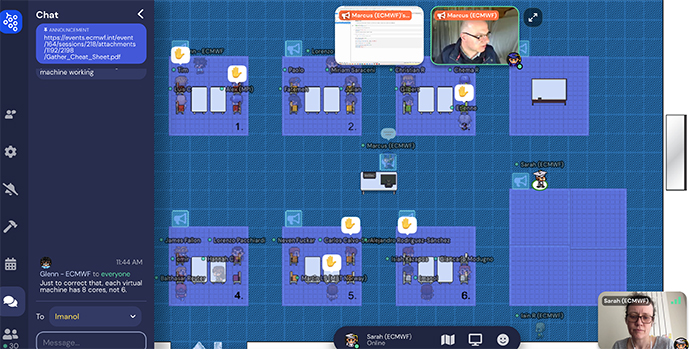The numerical weather prediction (NWP) training courses run by ECMWF faced a new challenge this year as we embarked on another period of online training events. The question was how to try and replicate the classroom practical learning experience, especially when we did not want to postpone our new, OpenIFS-based hands‑on Introduction to NWP for another year. A fundamental component of meeting the challenge is the European Weather Cloud. Cloud technologies allow us to provide each course participant with convenient and easy access to the same computing environment, a training lab, no matter what their local machine is. Each individual training lab instance can be provisioned on demand and tailored for each particular course. The European Weather Cloud, whose main purpose is to deliver data access and cloud-based processing capabilities for the European Meteorological Infrastructure (EMI) and its users, was the perfect fit for this activity. With this solution, each participant could have enough compute power to run a six-day forecast at TL255, which is the resolution of the seasonal forecast, in under 30 minutes.

Web-based courses
The decision was taken early on that for the new hands‑on course the participants should only need to have access to a web browser to interact with all the training material. This meant developing all our training, including running OpenIFS and visualising it with Metview, within the JupyterLab environment (see box for more details). A new set of high-level Metview Python functions were created to aid data exploration and will shortly be released publicly. This new development can utilise the Jupyter environment and provides OpenIFS users with an easy way to visualise experiments with suitable visualisation styles for each meteorological variable, including animations, differences and ensemble plotting.
The other challenge was to create a classroom in which instructors and participants could interact with each other in a similar way as when seated side by side, working in teams or being instructed or discussing things as a group. For this we used a piece of proximity video chat software called Gather. This allows interactions over video, audio and screen shares when participants’ avatars are physically close in the virtual world. Participants sat in our virtual classroom in groups and worked together; instructors could walk round the virtual world seeing how people were getting on as well as talking to the whole class (see screenshot). Training videos about how to use each piece of technology were created, making sure that each participant could have a positive virtual classroom experience.
What is a JupyterLab?
JupyterLab is a popular web-based user interface to your underlying computing platform that enables you to work with documents and activities such as Jupyter notebooks, text editors, terminals and many other features. You can arrange multiple documents and activities side by side in the work area using tabs and splitters, all without leaving your web browser. The notebooks running in the lab allow for users to interact with instructor-developed notebooks to play with code and visualise data.
Looking to the future
The cloud technology was used for all the NWP courses this year, and over 130 participants were taught in the virtual classroom. The opportunity to have a practical element to the course was appreciated by participants to help them engage with and consolidate the training material. Nevertheless, many survey respondents strongly favoured the return to face-to-face training as soon as possible. Participants missed the informal networking and the time and space to focus solely on the training event by being at ECMWF. Going forward we will need to determine the most optimal way to deliver high-quality training events while maintaining accessibility. Whatever the coming years bring, the work to move our practical training to be deployed on the European Weather Cloud means that we can take our training to any of our sites and know that our practical sessions will run. This gives us the flexibility to tailor each course, picking from our library of material that has been prepared for the cloud and delivering the course material through whichever form is most appropriate.
